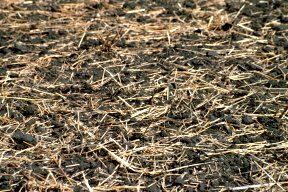Quick links
trash cover
DCHP-2 (May 2013)
n. — Agriculture, Prairies, especially Alberta
leftover organic material placed on top soil to preserve moisture and prevent erosion (see Image 1).
Type: 1. Origin — Trash cover farming seems to have been first developed in Canada to deal with dust bowl conditions during the Great Depression in the 1930s. William H. Fairfield was superintendent of the Lethbridge Experimental House (see AARD reference), one of six stations developed by the Dominion Department of Agriculture to address problems such as drought and erosion (see Archives Canada reference). Fairfield, hailing from Pennsylvania, was responsible for introducing trash cover farming in Alberta. The practice quickly became popular throughout the Prairies. Database searches suggest that the term was first used in Canada (see the 1935 quotation), where it is most prevalent today (see Chart 1), specifically in the Prairie province of Alberta (see Chart 2).
See also COD-2, s.v. "trash cover", which is marked "Cdn".
See also COD-2, s.v. "trash cover", which is marked "Cdn".
Quotations
1935
For those who may not be familiar with what is meant by a trash cover it may be stated that trash cover consists of stubble, weeds, and similar material left on the surface of the soil but incorporated sufficiently to anchor it and prevent it from drifting.
1943
A reduction in soil drifting in southern Alberta during recent years is due to an increase in strip farming and improved summer fallowing practises as well as more favorable winter conditions, according to the federal experimental station at Lethbridge. Trash cover fallows have almost completely replaced plowed fallows in all districts and farmers have learned to make good trash covers.
1952
You can't dispense with trash cover if you value your land at all. Trash cover holds moisture in the soil when you want it. It decays to provide food for your crops. It prevents soil drifting and water erosion. It shelters the soil from the pouding effect of rain and prevents puddling and sealing of the soil surface.
1978
Notable contributions have been made in the areas of strip farming, trash cover, N, P, K and S fertilization, irrigation management, crop rotations, and remote-sensing surveys.
1989
A trash cover also cushions the impact of driving rain on youmg [sic] plants and provides for better infiltration of water.
1999
It was a V-shaped cultivator allowing farmers to cut off weeds at the root, killing them while maintaining the integrity of "trash cover" -- stubble from earlier crops -- which was essential to anchoring the soil and retaining moisture.
2005
New techniques included listing -- digging the soil at right angles to the wind to prevent drifting -- and trash-cover farming.
2012
Erosion is less of an issue now since farmers have almost all converted to at least minimum tillage systems, and most employ zero-tillage which leaves sufficient trash cover to deal with wind.
2016
However, tillage often increases the risk of wind and water erosion because of its adverse effects on soil structure and its partial destruction of trash cover. Tillage is most effective when used in combination with other measures, such as timely application of selective herbicides, sowing of barley and rye as competitive crops, and seeding fields to forage crops.
References
- COD-2
- AARD • "Fairfield, William H. - 1974 Hall of Fame Inductee"
- Archives Canada • "Lethbridge Research Station"
Images
